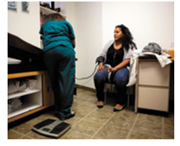
23-Year-Old Female with Menstrual Irregularity
Jasmine Herrera, 23, has been referred to the endocrinology clinic. She is very overweight, with obvious acne and facial hair. She complains of irregular menstrual cycles. “My husband and I want to use the rhythm method," she says, “but I don’t have any rhythm!”

6. NCLEX-STYLE Jasmine is started on oral contraceptives containing a combination of an estrogen and progesterone. These will regulate her menstrual cycles and decrease her androgen level. They will also act to prevent pregnancy by preventing ovulation. What phase of the uterine cycle is caused by sustained elevation of both estrogen and progesterone levels?
a. Proliferative phase
b. Follicular phase
c. Secretory phase
d. Menstrual phase
Want to see the full answer?
Check out a sample textbook solution
Chapter 27 Solutions
Human Anatomy & Physiology Plus Mastering A&P with Pearson eText -- Access Card Package (11th Edition) (What's New in Anatomy & Physiology)
- Samira is a 26-year-old female with a history of intense dysmenorrhea. She experienced menarche at age 11. Her menstrual cycles average 25 days in length. She has a BMI of 18. Her menstrual cycle pain had decreased over the last 3 years while she was consistently taking birth control pills. However, she is now planning her first pregnancy and has been off birth control for 6 months. She has yet to conceive, even though she and her partner have been carefully timing intercourse and monitoring Samira’s fertility window each month. Her dysmenorrhea has returned, and she has developed menometrorrhagia, along with other cyclical symptoms like diarrhea, bloating, and craving salty foods. List and describe 3 lifestyle or at-home treatments that may help Samira reduce her symptoms.arrow_forwardSamira is a 26-year-old female with a history of intense dysmenorrhea. She experienced menarche at age 11. Her menstrual cycles average 25 days in length. She has a BMI of 18. Her menstrual cycle pain had decreased over the last 3 years while she was consistently taking birth control pills. However, she is now planning her first pregnancy and has been off birth control for 6 months. She has yet to conceive, even though she and her partner have been carefully timing intercourse and monitoring Samira’s fertility window each month. Her dysmenorrhea has returned, and she has developed menometrorrhagia, along with other cyclical symptoms like diarrhea, bloating, and craving salty foods. Why would Samira’s dysmenorrhea symptoms decrease when taking birth control pillarrow_forwardSamira is a 26-year-old female with a history of intense dysmenorrhea. She experienced menarche at age 11. Her menstrual cycles average 25 days in length. She has a BMI of 18. Her menstrual cycle pain had decreased over the last 3 years while she was consistently taking birth control pills. However, she is now planning her first pregnancy and has been off birth control for 6 months. She has yet to conceive, even though she and her partner have been carefully timing intercourse and monitoring Samira’s fertility window each month. Her dysmenorrhea has returned, and she has developed menometrorrhagia, along with other cyclical symptoms like diarrhea, bloating, and craving salty foods. Which of Samira’s symptoms is most likely NOT related to endometriosis? Craving salty food Diarrhea Dysmenorrhea Bloatingarrow_forward
- Samira is a 26-year-old female with a history of intense dysmenorrhea. She experienced menarche at age 11. Her menstrual cycles average 25 days in length. She has a BMI of 18. Her menstrual cycle pain had decreased over the last 3 years while she was consistently taking birth control pills. However, she is now planning her first pregnancy and has been off birth control for 6 months. She has yet to conceive, even though she and her partner have been carefully timing intercourse and monitoring Samira’s fertility window each month. Her dysmenorrhea has returned, and she has developed menometrorrhagia, along with other cyclical symptoms like diarrhea, bloating, and craving salty foods. Samira’s physician is concerned that she may have endometriosis. Briefly explain the pathophysiology of this condition.arrow_forward\ Samira is a 26-year-old female with a history of intense dysmenorrhea. She experienced menarche at age 11. Her menstrual cycles average 25 days in length. She has a BMI of 18. Her menstrual cycle pain had decreased over the last 3 years while she was consistently taking birth control pills. However, she is now planning her first pregnancy and has been off birth control for 6 months. She has yet to conceive, even though she and her partner have been carefully timing intercourse and monitoring Samira’s fertility window each month. Her dysmenorrhea has returned, and she has developed menometrorrhagia, along with other cyclical symptoms like diarrhea, bloating, and craving salty foods. List and briefly describe 3 risk factors Samira has for endometriosis.arrow_forwardMrs. Zexy Lucero, 30 years old, G1P0, 6 weeks by LMP presents at the lying in clinic for prenatal check-up. History revealed a Type 1 diabetes since 14 years of age, history of diabetic nephropathy and proliferative retinopathy and is bothered about the effects on her baby. Which of the following statements about diabetes in pregnancy needs further instructions? (SELECT ALL THAT APPLIES) a. Diabetes ketoacidosis is a common complication during the first trimester. b. Glycosylated hemoglobin levels are poor predictors of the risk of congenital malformations c. Proteinuria over 300 mg/dL is associated with increased risk of preeclampsia. d. The risk of fetal chromosomal abnormalities is increased.arrow_forward
- A G1P0 pregnant client presents at the prenatal clinic: What is the Expected Date of Delivery (EDD) using Naegele’s Rule for a woman who has had their Last Menstrual Period (LMP) on: LMP: Mar. 28, 2021arrow_forwardWhich term would the nurse use in a report to describe the absence of menstrual periods in a 35-year-old nonpregnant client? Rhinorrhea Menopause Amenorrhea. Dyspareunia.arrow_forwardCase ScenarioA 22-year-old woman, gravida 2, para 1, presents at the maternity clinic for a prenatal visit. She is unsure of her due date and states that her last menstrual period was about seven or eight months ago. She had one prenatal check-up in the community health center, although she does not have any records from her physician or nurse-midwife. She reports that she has had an uncomplicated pregnancy so far and that earlier ultrasonography indicated that she is going to have a girl. Her medical history is unremarkable aside from a full-term cesarean delivery performed in the government hospital four years ago because of “complete breech presentation.” She is not taking any prenatal vitamins. On examination, her vital signs are unremarkable, her fundal height measures 27 cm, the fetal heart rate is 165 beats per minute, and the fetus is cephalic by Leopold’s maneuvers. 1. What is your insight on the patient’s case concerning her pregnancy? 2. How can you best minimize risks…arrow_forward
- Mrs. Aunor a 43-year-old G1PO comes into the Maternity Center for her routine OB visit at 38 weeks. She denies any problems since she was seen the week before She reports good fatal movement and dentes any leakage of fluid per vagina, vaginal bleeding or regular uterine contractions. She reports that sometimes she feels crampy at the end of the day when she gets home from work, but this discomfort is alleviated with getting off her feet. The fundal height measurement is 36 cm; it measured 37 cm the week before. Her cervical examination is 2 cm dilated. Which of the following is the most appropriate next step in the management of this patient? a. Instruct the patient to return to the center in 1 week for her next routine visit b. Send the patient for a sonogram to determine the amniotic fluid index c. Order the patient to undergo a nonstress test d. Do a ferm test in the office e. Admit the patient for induction caused by diagnosis of fetal growth legarrow_forwardP09. Answer -------Marielle, 18 year-old, Gravida 1 Para 039-40 weeks AOG, was brought to the Delivery Suite due to labor pains. On admission, BP = 110/80 ; FH = 34cm; FHT = 145 bpm. Internal examination showsCervix 3 cm, 60% effaced; intact BOW, station -2; cephalic presentation. Uterine contractions were occurring at every 5-6 minutes interval, 30 seconds durationmild to moderate contractions. Marielle in this case is already in what phase of labor?a. Latent phaseb. Acceleration phasec. Phase of maximum sloped. Deceleration test.arrow_forwardClinical Case: A 37-year-old female and her 37-year-old husband present with the complaint of a possible fertility problem. The couple has been married for 2 years. The couple has been trying to conceive since then and reports a high degree of stress related to their lack of success. The patient reports good health, stated that her periods were regular, having periods with a normal cycle. She works as a cashier, runs 12-24 miles each week for the last 2 years, and has no history of STDs, abnormal Paps, smoking, alcohol, or other drugs. She has had no surgery. The patient's partner also reports good health and reports no problems with erection, ejaculation, or pain with intercourse. He has had no prior urogenital infections or exposure to STDs. He has had unprotected sex prior to his current relationship but has not knowingly conceived. He has no medical problems or past surgery. He works as a long-distance truck driver and is on the road for 2-3 weeks each month. He smokes a pack of…arrow_forward
- Understanding Health Insurance: A Guide to Billin...Health & NutritionISBN:9781337679480Author:GREENPublisher:Cengage

